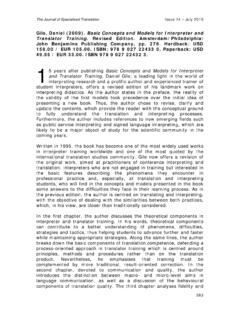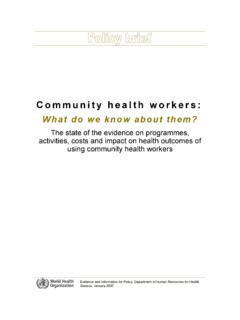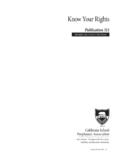Transcription of Community interpreting: breaking with the ‘norm’ …
1 The Journal of Specialised Translation Issue 14 July 2010 11 Community interpreting: breaking with the norm through normalisation carmen toledano Buend a, university of La Laguna (Spain) ABSTRACT In this paper the concept of norm, that has been widely applied in Translation Studies, has been extended to the field of Community Interpreting. From this approach, Community interpreting is explained in relation to the socio-historical contexts in which it takes place and the normative framework that shapes it. We also explore how the current situation of de-regularisation affecting this activity in many countries hinders the development of a specific norm framework for Community interpreting and as such its consolidation as an independent discipline. Not only that, it also affects the very nature of the activity as interpreter s performance and product is defined by norms and values held by other agents involved in interpreter-mediated encounters.
2 In these cases universities can play a very important role as a norm-setting authority by providing research, training and informative activities. KEYWORDS Community interpreting, translation norms, interpreting norms, professionalisation. Over the last 15 years, there have been reports of advances in the field of Community interpreting from academics and professionals alike. With the increase in specialised conferences, research activities, publications and training courses, Community Interpreting has developed as a branch of Interpreting Studies in its own right. Additionally, the global movement of populations and the resulting increase in the number of multicultural societies has set in motion a process of Community interpreter professionalisation that is being reflected in the emergence of educational programmes, interpreters associations and accreditation systems.
3 However, there is still a long way to go before it is possible to agree entirely with the statement by Harris that the right to communicate with the powers that be in one s own language has become a right not a concession, (Harris 2000: 1) and be able to add to this statement that this right is enshrined with quality control guarantees. The reality is that there are still many issues to be investigated, many interpreters to be trained, and many sectors of society to educate about the complex nature of Community interpreting, and above all, the importance of (and the risks of no-) professionalisation. The provision of quality controlled interpreting still continues to be an issue that poses problems that require satisfactory solutions in many countries, most noticeably in areas where immigration and the influx of foreigners is a comparatively recent phenomenon.
4 Having reflected on this, Ozolins develops a continuum to represent how countries respond to interpreting needs and outlines responses that range from those that deny existence of the issue (an ever diminishing number), through countries that rely on ad hoc services, to generic language services, to fully comprehensive responses of training, service provision and accreditation. (2000: 22) The Journal of Specialised Translation Issue 14 July 2010 12 In this paper, our focus is on the situation of Community interpreting among the second group of countries, those in which Community interpreting professionalism has not yet been recognised and validated by any governing body. According to Ozolins, a characteristic of these countries is that There is no concept of training, little thought of accreditation or registration, but response to an immediate need is given by using available bilinguals, (2000: 23) even in those areas, such as the courts, in which linguistic services may be guaranteed by law.
5 In other words, these countries lack a set of specific and generally accepted interpreting norms that can be used to regulate the Community interpreter process and their product. Put bluntly, non-professionalised interpreting is the norm . If a great many of de facto Community interpreting problems arise from the normalisation of a lack of norms, then it would probably be wise to first look at the concept of norms widely applied in Translation Studies. By doing so, we aim to explain the nature of Community interpreting and its relationship to the social context in which is embedded and the different normative levels that determine it. We will also consider the importance of establishing a set of norms for Community interpreting, process and product norms, in order to guarantee professional independency and quality performance.
6 Universities can play a very important part in this processes as a norm-setting authority, providing education and by raising awareness of the creation and adherence to Community interpreting norms. The concept of norm in Translation Studies The concept of norms was initially conceived in the social sciences, not within the field of Translation Studies. According to the social sciences, norms define appropriate reciprocal behaviour based on consensus and, as a consequence of this, the types of actions they regulate give shape to the institutional framework within a society. Therefore, within the social sciences norms are not seen as a limiting factor, but rather norms play an important role in social organisation. This concept of norms is applied across different disciplines, a fact which demonstrates its interdisciplinary relevance and applicability for understanding a wide range of human behaviours.
7 This notion of norm has been one of the central concepts in Translation Studies. The evolution of Translation Studies has shown that translation (understood in the widest sense of the word) is influenced and constrained by different factors much more complex than the linguistic differences existing between the two languages involved. Any translation activity is a human activity that takes place in a social, cultural and historical situation, and just as with any other social behaviour is regulated by norms (Sch ffner 1999: 7). Consequently, it is necessary to recognise and accept that any universal and objective criteria that are relied upon to validate and assess products and processes involved within the discipline The Journal of Specialised Translation Issue 14 July 2010 13are therefore embedded in normative frameworks that have been shaped historically and socially.
8 Despite their directive character, norms are not perceived as formal regulations that are vertically imposed. On the contrary, norms are normally aquired through repetitive behaviour, not through the imposition of laws and their enforcement, as such norms depend on deductive activity to take place when experiencing repetitive behaviour patterns. Regularity implies that a specific behaviour is preferred over another one in a specific situation of a given type by the majority, if not all, members of a Community (Toury 1978: 84). Among a variety of options, a particular course of action is more or less strongly preferred because the Community has agreed to accept it as proper, correct or appropriate. (Hermans 1996: 31) This preference defines what is considered correct and as such, it can then serve as evaluative criteria.
9 Norms mediate between the individual and the collective, between the individual s intentions, choices and actions and collectively held beliefs, values and preferences. Because of this, norms play a very important role in the interaction between groups of people (Hermans 1996: 26-27). The normative power of norms should not be understood from a Manichaean perspective but in Foucaultian terms because they not only have a repressive force but also a creative one: What makes power hold good, what makes it accepted, is simply the fact that it doesn t only weigh on us as a force that says no, but that it traverses and produces things, it induces pleasure, forms knowledge, produces discourse. It needs to be considered as a productive network which runs through the whole social body, much more than as a negative instance whose function is repression.
10 (Foucault 1984: 61) Toury was the first to introduce the concept of norms to Translation Studies (1978) as a tool to define the existence of the translation concept in specific historical contexts and describe equivalence relationships. Norms are, the intermediating factor between the system of potential equivalence relationships and the actual performance, , the reason for the functioning of certain relationships as translation equivalence. (1981: 24) They may also have an explanatory and predictive value that is closely related to the descriptive function of translation norms by providing a source of explanation for the choices and decisions that translators make. Other authors such as Chesterman (1993) and Komissarov (1993) have added an evaluative function to the descriptive and explanatory values of norms conceived by Toury.






